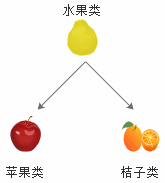#题记:
有一水果类,抽象出属性包括:name(水果品种),price(价格),id(ID号)。现有两个子类,分别为苹果,桔子,希望继承水果父类。
一、构造函数继承
构造函数继承相当把父类的属性在子类执行一遍(可以理解为复制一遍),代码如下:
//父类:水果类 function Fruit(name, price, id) { this.name = name; this.price = price; this.id = id; } //苹果类 function Apple(name, price, id) { Fruit.call(this, name, price, id); //执行一遍父类的属性 } //桔子类 function Orange(name, price, id) { Fruit.call(this, name, price, id); //执行一遍父类的属性 } var apple = new Apple('苹果', '10.5', '001'); //实例苹果,可以传参了 var orange = new Orange('桔子', '8.5', '002'); //实例桔子,可以传参了 console.log(apple.name); console.log(orange.price);
二、构造函数解决的优点和缺点
一、优点
构造函数解决了原型继承中不能向父类传参的问题,它能灵活的向父类传送参数。并且继承的属性完全属于自己,不会和其它的子类产生影响。示例图:

二、缺点
构造函数继承不能继承父类的原型方法,参照这些条件,自然想到可以将它们组合一起。
三、组合继承
组合继承即是把原型继承和构造函数继承组合一起。
示例代码如下
//父类:水果类 function Fruit(name, price, id) { this.name = name; this.price = price; this.id = id; } Fruit.prototype.getInfo=function() { console.log(this.name + ',' + this.price + ',' + this.id); } //苹果类 function Apple(name, price, id) { Fruit.call(this, name, price, id); //执行一遍父类的属性 } //桔子类 function Orange(name, price, id) { Fruit.call(this, name, price, id); //执行一遍父类的属性 } Apple.prototype = new Fruit(); //继承了父类的原型方法 Orange.prototype = new Fruit(); //继承了父类的原型方法 var apple = new Apple('苹果', '10.5', '001'); //实例苹果,传参 var orange = new Orange('桔子', '8.5', '002'); //实例桔子,传参 apple.getInfo(); //输出'苹果', '10.5', '001' orange.getInfo(); //输出'桔子', '8.5', '002'
一、组合继承的优点和缺点
优点是:几乎很完美了,既能独立继承父类的属性,也能继承父类的原型方法。
缺点是:父类的构造函数执行了两遍,一次在call调用时,一次在原型继承时。


